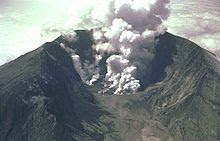 |
| Erupting volcano |
Giselle's MA in English was apparently not up to the task of writing about something so science-y that fifth graders make models of them for science fairs, volcanoes – which Giselle says are
"...large raised holes in the planet that can push large amounts of hot lava out onto the planet's surface..."
- "This scale works just like the Richter scale, which measures the amplitude of earthquakes": The Richter scale describes magnitude, not amplitude. They do both have "-tude" in them, though, so we guess that's "close enough."
- "No. 5 on the scale are eruptions that happen every 10 years, give or take. No. 6 are eruptions that happen every 100 years. When it comes to 7, they happen every 1,000 years or so...": Every 10 years, "give or take"? Every 1,000 years or so? You gotta be kidding us. Can she really be that dumb or is she just that bad at condensing information...
- "All these eruptions are put into this scale based on math termed as logarithms. Each number equates to an eruption that is 10 times bigger than the one before it." : Apparently she doesn't know what a logarithmic scale is (though most people do...) And we find "an eruption that is 10 times bigger than the one before it" rather ambiguous, don't you?
We found Giselle's description of "How the VEI Works" especially... errr, enlightening:
"When a volcano erupts, the explosiveness is then measured. The amount of matter ejected from the volcano and how tall the clouds are are then measured. The debris, such as ash, gas and rock, are lumped into one. They are known by the term Dense-Rock Equivalent, or DRE. This is then assessed to tell how much lava has been pushed out of the volcano."If the people at Demand Media think that writing's up to their vaunted standards, then they need to re-visit their shelf of AP Stylebooks. Frankly, it's plain lousy writing and about half wrong to boot. That's why, yet once more, eHow provides a Dumbass of the Day -- and we're pretty sure Giselle won't be their last. |
copyright © 2015-2021 scmrak
SI - VOLCANOES

No comments:
Post a Comment